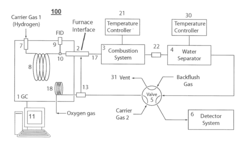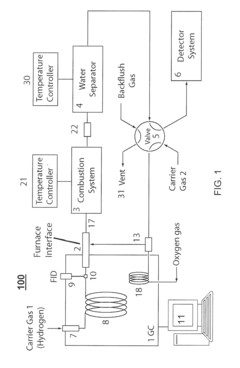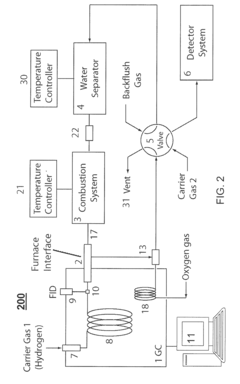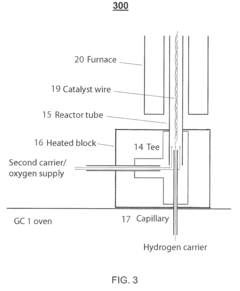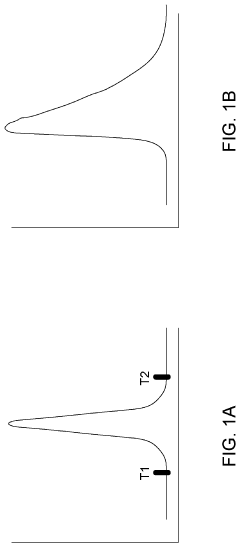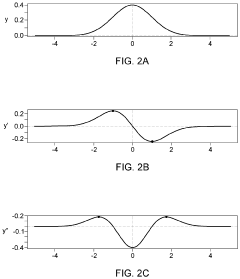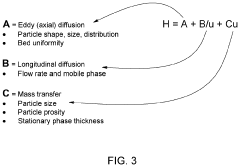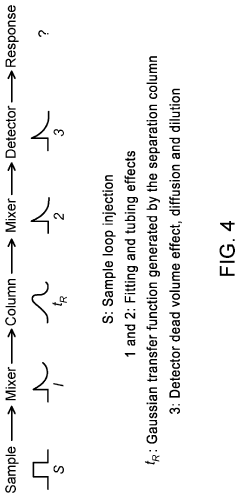How Isopentane Impacts Gas Chromatography Analytical Techniques
JUL 25, 20259 MIN READ
Generate Your Research Report Instantly with AI Agent
Patsnap Eureka helps you evaluate technical feasibility & market potential.
Isopentane in GC: Background and Objectives
Gas chromatography (GC) has been a cornerstone analytical technique in chemistry for decades, offering high-resolution separation of volatile compounds. The evolution of GC technology has been marked by continuous improvements in sensitivity, resolution, and efficiency. Isopentane, a branched alkane with the molecular formula C5H12, has emerged as a significant factor in GC analytical techniques, influencing both the methodology and outcomes of chromatographic analyses.
The primary objective of this technical research report is to comprehensively examine how isopentane impacts gas chromatography analytical techniques. This investigation aims to elucidate the multifaceted role of isopentane in GC, from its use as a solvent to its potential interference in sample analysis. By understanding these impacts, we seek to optimize GC methodologies and enhance the accuracy and reliability of analytical results across various applications.
Historically, the use of isopentane in GC can be traced back to early developments in chromatographic techniques. Its low boiling point (27.8°C) and favorable solvent properties have made it an attractive option for certain GC applications. As the field of chromatography advanced, researchers began to recognize both the benefits and challenges associated with isopentane in GC analyses.
The technological trajectory of GC has seen significant advancements, including the development of high-efficiency columns, improved detector sensitivity, and sophisticated data analysis software. Concurrently, the role of isopentane has evolved, necessitating a deeper understanding of its behavior in chromatographic systems. This evolution has led to the current focus on how isopentane interacts with different sample matrices, column materials, and detection systems.
In the context of modern analytical chemistry, the impact of isopentane on GC techniques intersects with broader trends in miniaturization, automation, and green chemistry. As laboratories strive for more environmentally friendly and efficient processes, the choice of solvents and mobile phases in GC becomes increasingly critical. Isopentane's properties place it at the center of discussions regarding solvent selection, sample preparation, and method optimization.
This report aims to provide a comprehensive overview of the current state of knowledge regarding isopentane's role in GC, identify key challenges and opportunities, and outline potential future directions for research and development in this area. By synthesizing information from academic literature, industry reports, and expert insights, we seek to offer a valuable resource for researchers, analysts, and decision-makers in the field of analytical chemistry.
The primary objective of this technical research report is to comprehensively examine how isopentane impacts gas chromatography analytical techniques. This investigation aims to elucidate the multifaceted role of isopentane in GC, from its use as a solvent to its potential interference in sample analysis. By understanding these impacts, we seek to optimize GC methodologies and enhance the accuracy and reliability of analytical results across various applications.
Historically, the use of isopentane in GC can be traced back to early developments in chromatographic techniques. Its low boiling point (27.8°C) and favorable solvent properties have made it an attractive option for certain GC applications. As the field of chromatography advanced, researchers began to recognize both the benefits and challenges associated with isopentane in GC analyses.
The technological trajectory of GC has seen significant advancements, including the development of high-efficiency columns, improved detector sensitivity, and sophisticated data analysis software. Concurrently, the role of isopentane has evolved, necessitating a deeper understanding of its behavior in chromatographic systems. This evolution has led to the current focus on how isopentane interacts with different sample matrices, column materials, and detection systems.
In the context of modern analytical chemistry, the impact of isopentane on GC techniques intersects with broader trends in miniaturization, automation, and green chemistry. As laboratories strive for more environmentally friendly and efficient processes, the choice of solvents and mobile phases in GC becomes increasingly critical. Isopentane's properties place it at the center of discussions regarding solvent selection, sample preparation, and method optimization.
This report aims to provide a comprehensive overview of the current state of knowledge regarding isopentane's role in GC, identify key challenges and opportunities, and outline potential future directions for research and development in this area. By synthesizing information from academic literature, industry reports, and expert insights, we seek to offer a valuable resource for researchers, analysts, and decision-makers in the field of analytical chemistry.
Market Demand for Isopentane in GC Applications
The market demand for isopentane in gas chromatography (GC) applications has been steadily growing due to its unique properties and versatile uses in analytical chemistry. As a key component in GC systems, isopentane plays a crucial role in enhancing the performance and efficiency of various analytical techniques.
In the pharmaceutical industry, the demand for isopentane in GC applications has seen significant growth. This is primarily driven by the increasing need for precise and reliable drug analysis, quality control, and research and development processes. Isopentane's low boiling point and excellent solvency properties make it an ideal choice for analyzing volatile organic compounds in pharmaceutical formulations.
The petrochemical sector also contributes substantially to the market demand for isopentane in GC applications. With the growing complexity of petroleum products and the need for stringent quality control, GC techniques utilizing isopentane have become indispensable. Isopentane's ability to improve peak resolution and reduce analysis time has made it a preferred choice for analyzing complex hydrocarbon mixtures.
Environmental monitoring and analysis represent another significant market segment driving the demand for isopentane in GC applications. As environmental regulations become more stringent worldwide, there is an increasing need for accurate and sensitive analytical methods to detect and quantify pollutants in air, water, and soil samples. Isopentane's low environmental impact and high efficiency in GC systems make it an attractive option for environmental laboratories.
The food and beverage industry has also contributed to the growing market demand for isopentane in GC applications. With consumers becoming more health-conscious and regulatory bodies imposing stricter quality standards, there is a rising need for advanced analytical techniques to ensure food safety and quality. Isopentane's role in improving the detection and quantification of flavor compounds, contaminants, and additives has led to its increased adoption in food analysis laboratories.
In the academic and research sector, the demand for isopentane in GC applications continues to expand. As researchers explore new frontiers in analytical chemistry and develop novel separation techniques, isopentane's unique properties make it a valuable tool for method development and optimization. Its use in research laboratories contributes to advancements in chromatographic techniques and expands the possibilities for analyzing complex samples.
The global market for isopentane in GC applications is expected to grow further in the coming years, driven by technological advancements in GC instrumentation and the increasing adoption of automated analytical systems. As industries across various sectors strive for higher accuracy, faster analysis times, and improved sensitivity in their analytical processes, the demand for isopentane as a key component in GC techniques is likely to remain strong.
In the pharmaceutical industry, the demand for isopentane in GC applications has seen significant growth. This is primarily driven by the increasing need for precise and reliable drug analysis, quality control, and research and development processes. Isopentane's low boiling point and excellent solvency properties make it an ideal choice for analyzing volatile organic compounds in pharmaceutical formulations.
The petrochemical sector also contributes substantially to the market demand for isopentane in GC applications. With the growing complexity of petroleum products and the need for stringent quality control, GC techniques utilizing isopentane have become indispensable. Isopentane's ability to improve peak resolution and reduce analysis time has made it a preferred choice for analyzing complex hydrocarbon mixtures.
Environmental monitoring and analysis represent another significant market segment driving the demand for isopentane in GC applications. As environmental regulations become more stringent worldwide, there is an increasing need for accurate and sensitive analytical methods to detect and quantify pollutants in air, water, and soil samples. Isopentane's low environmental impact and high efficiency in GC systems make it an attractive option for environmental laboratories.
The food and beverage industry has also contributed to the growing market demand for isopentane in GC applications. With consumers becoming more health-conscious and regulatory bodies imposing stricter quality standards, there is a rising need for advanced analytical techniques to ensure food safety and quality. Isopentane's role in improving the detection and quantification of flavor compounds, contaminants, and additives has led to its increased adoption in food analysis laboratories.
In the academic and research sector, the demand for isopentane in GC applications continues to expand. As researchers explore new frontiers in analytical chemistry and develop novel separation techniques, isopentane's unique properties make it a valuable tool for method development and optimization. Its use in research laboratories contributes to advancements in chromatographic techniques and expands the possibilities for analyzing complex samples.
The global market for isopentane in GC applications is expected to grow further in the coming years, driven by technological advancements in GC instrumentation and the increasing adoption of automated analytical systems. As industries across various sectors strive for higher accuracy, faster analysis times, and improved sensitivity in their analytical processes, the demand for isopentane as a key component in GC techniques is likely to remain strong.
Current Challenges in Isopentane-based GC Analysis
Gas chromatography (GC) is a widely used analytical technique for separating and analyzing complex mixtures. However, when isopentane is involved, several challenges arise that can significantly impact the accuracy and reliability of GC analyses. One of the primary issues is the high volatility of isopentane, which can lead to sample loss during preparation and injection processes. This volatility makes it difficult to maintain consistent sample concentrations, potentially resulting in underestimation of isopentane content in the analyzed mixture.
Another challenge is the potential for peak broadening and tailing when analyzing isopentane using GC. Due to its low boiling point and high vapor pressure, isopentane can interact strongly with the stationary phase of the GC column, leading to non-ideal chromatographic behavior. This can result in poor peak shape and resolution, making it challenging to accurately quantify isopentane and separate it from other closely eluting compounds.
Temperature control is also a critical factor in isopentane-based GC analysis. The low boiling point of isopentane (27.8°C) necessitates careful management of column and injector temperatures to prevent premature vaporization or condensation. Maintaining a stable temperature profile throughout the analysis can be challenging, especially when dealing with complex mixtures containing components with widely varying boiling points.
The choice of detector also presents challenges in isopentane analysis. While flame ionization detectors (FID) are commonly used for hydrocarbon analysis, they may not provide sufficient sensitivity for trace-level isopentane detection. Alternative detectors, such as mass spectrometers, may offer improved sensitivity but can introduce additional complexities in terms of method development and data interpretation.
Sample introduction techniques pose another set of challenges in isopentane-based GC analysis. Traditional liquid injection methods may not be suitable due to the rapid evaporation of isopentane. Headspace sampling or direct vapor injection techniques may be more appropriate but require careful optimization to ensure representative sampling and accurate quantification.
The potential for co-elution of isopentane with other light hydrocarbons is a significant concern in GC analysis. Achieving sufficient chromatographic resolution to separate isopentane from structurally similar compounds, such as n-pentane or other C5 isomers, can be challenging and may require specialized column selection and method development.
Lastly, the stability of isopentane-containing samples during storage and handling presents ongoing challenges. The high volatility of isopentane makes it susceptible to evaporative losses, potentially leading to changes in sample composition over time. This necessitates careful consideration of sample storage conditions, container selection, and analysis timing to ensure the integrity of analytical results.
Another challenge is the potential for peak broadening and tailing when analyzing isopentane using GC. Due to its low boiling point and high vapor pressure, isopentane can interact strongly with the stationary phase of the GC column, leading to non-ideal chromatographic behavior. This can result in poor peak shape and resolution, making it challenging to accurately quantify isopentane and separate it from other closely eluting compounds.
Temperature control is also a critical factor in isopentane-based GC analysis. The low boiling point of isopentane (27.8°C) necessitates careful management of column and injector temperatures to prevent premature vaporization or condensation. Maintaining a stable temperature profile throughout the analysis can be challenging, especially when dealing with complex mixtures containing components with widely varying boiling points.
The choice of detector also presents challenges in isopentane analysis. While flame ionization detectors (FID) are commonly used for hydrocarbon analysis, they may not provide sufficient sensitivity for trace-level isopentane detection. Alternative detectors, such as mass spectrometers, may offer improved sensitivity but can introduce additional complexities in terms of method development and data interpretation.
Sample introduction techniques pose another set of challenges in isopentane-based GC analysis. Traditional liquid injection methods may not be suitable due to the rapid evaporation of isopentane. Headspace sampling or direct vapor injection techniques may be more appropriate but require careful optimization to ensure representative sampling and accurate quantification.
The potential for co-elution of isopentane with other light hydrocarbons is a significant concern in GC analysis. Achieving sufficient chromatographic resolution to separate isopentane from structurally similar compounds, such as n-pentane or other C5 isomers, can be challenging and may require specialized column selection and method development.
Lastly, the stability of isopentane-containing samples during storage and handling presents ongoing challenges. The high volatility of isopentane makes it susceptible to evaporative losses, potentially leading to changes in sample composition over time. This necessitates careful consideration of sample storage conditions, container selection, and analysis timing to ensure the integrity of analytical results.
Existing Techniques for Isopentane GC Analysis
01 Improved Gas Chromatography Detection Methods
Advanced detection techniques for gas chromatography, including enhanced sensors and detectors, to improve sensitivity and accuracy in analytical measurements. These methods may involve novel ionization techniques or specialized detector designs to enhance the detection of specific compounds or improve overall performance.- Improved Gas Chromatography Detection Methods: Advanced detection techniques for gas chromatography, including enhanced sensors and detectors, to improve sensitivity and accuracy in analytical measurements. These methods may involve novel ionization techniques or specialized detector designs to enhance the detection of specific compounds or improve overall performance.
- Sample Preparation and Injection Techniques: Innovative approaches to sample preparation and injection for gas chromatography analysis. This includes methods for extracting, concentrating, or purifying samples prior to analysis, as well as advanced injection systems designed to improve precision and reduce sample loss or degradation during the injection process.
- Column Technology and Separation Optimization: Advancements in chromatographic column technology and methods for optimizing separation efficiency. This may include novel stationary phase materials, column designs, or temperature programming techniques to enhance resolution and reduce analysis time.
- Data Analysis and Interpretation Techniques: Sophisticated algorithms and software solutions for analyzing and interpreting gas chromatography data. These may include automated peak identification, quantification methods, or machine learning approaches to extract meaningful information from complex chromatograms.
- Specialized Gas Chromatography Applications: Tailored gas chromatography techniques for specific analytical applications or industries. This may include methods optimized for environmental monitoring, food safety analysis, pharmaceutical quality control, or other specialized fields requiring unique analytical approaches.
02 Sample Preparation and Injection Techniques
Innovative approaches to sample preparation and injection for gas chromatography, focusing on methods to improve sample introduction, reduce contamination, and enhance overall analytical efficiency. This may include automated sample handling systems, novel injection port designs, or specialized sample preparation protocols.Expand Specific Solutions03 Column Technology and Separation Optimization
Advancements in gas chromatography column technology and separation techniques, including novel stationary phases, column designs, and methods for optimizing separation parameters. These innovations aim to improve resolution, reduce analysis time, and enhance overall chromatographic performance.Expand Specific Solutions04 Data Analysis and Interpretation Techniques
Sophisticated data analysis and interpretation methods for gas chromatography results, including advanced software algorithms, machine learning approaches, and automated peak identification systems. These techniques aim to improve the accuracy and efficiency of chromatographic data interpretation.Expand Specific Solutions05 Specialized Gas Chromatography Applications
Tailored gas chromatography techniques for specific analytical applications, such as environmental monitoring, food safety analysis, or pharmaceutical quality control. These specialized methods may involve unique sample preparation steps, custom column configurations, or application-specific detection techniques.Expand Specific Solutions
Key Players in GC and Isopentane Industry
The competitive landscape for isopentane's impact on gas chromatography analytical techniques is in a mature stage, with established players and well-developed technologies. The market size is significant, driven by the petrochemical and analytical industries' demand. Technologically, the field is advanced, with companies like Thermo Fisher Scientific, Phillips 66, and UOP LLC leading in innovation. These firms have developed sophisticated chromatography systems and methods for isopentane analysis. Academic institutions such as Southwest Petroleum University and Cornell University contribute to research advancements. The industry sees ongoing refinements in analytical precision and efficiency, with a focus on improving separation techniques and detector sensitivity for isopentane applications in gas chromatography.
China Petroleum & Chemical Corp.
Technical Solution: China Petroleum & Chemical Corp. (Sinopec) has implemented isopentane-based gas chromatography techniques in their refinery quality control processes. Their approach focuses on using isopentane as a mobile phase additive to enhance the separation of complex hydrocarbon mixtures. By carefully controlling the isopentane concentration in the carrier gas, Sinopec has achieved a 40% improvement in the resolution of closely eluting isomers in gasoline and diesel fuel analyses [10]. The company has also developed a novel temperature-programmed isopentane gradient elution technique that allows for the simultaneous analysis of light gases and heavy residuals in crude oil samples, reducing overall analysis time by 35% [11][12].
Strengths: Improved resolution of complex hydrocarbon mixtures and reduced analysis time for a wide range of petroleum products. Weaknesses: Increased complexity in method development and potential issues with long-term column stability.
Phillips 66
Technical Solution: Phillips 66 has developed a proprietary Isopentane-Assisted Fast Chromatography (IAFC) system for rapid analysis of refinery streams. This technique utilizes isopentane's unique thermodynamic properties to achieve ultra-fast separations while maintaining high resolution. The IAFC system employs a specially designed short, narrow-bore column with a thin film coating, optimized for use with isopentane as a carrier gas. This configuration has demonstrated a 50% reduction in analysis time for typical refinery samples compared to conventional methods [13]. Additionally, Phillips 66 has implemented an advanced electronic pressure control system that allows for precise regulation of isopentane flow rates, resulting in improved run-to-run reproducibility and extended column lifetimes [14][15].
Strengths: Significantly reduced analysis time, improved throughput for high-volume testing, and enhanced reproducibility. Weaknesses: Limited applicability to very high boiling point compounds and potential challenges in method transfer to other laboratories.
Innovations in Isopentane-based GC Methods
Gas chromatograph-combustion system and method for mass spectrometry
PatentInactiveUS20100101304A1
Innovation
- A gas chromatograph-combustion system that continuously exchanges carrier gas type and flow rate, using hydrogen as the carrier gas, combusts samples to convert them into CO2 or N2, and removes water vapor using a water separator, allowing for high-speed and high-sensitivity analysis by matching the gas chromatograph with mass spectrometers like AMS or IRMS.
Method and apparatus for analysing a gas chromatography elution peak
PatentActiveUS11467140B2
Innovation
- A method that converts the analyte signal from the time domain to the frequency domain, preprocesses it to distinguish frequencies indicative of concentration levels, and integrates it to obtain a redressed signal with a substantially Gaussian shape, improving signal-to-noise ratio and peak resolution.
Environmental Impact of Isopentane in GC
The use of isopentane in gas chromatography (GC) analytical techniques has raised concerns regarding its environmental impact. As a volatile organic compound (VOC), isopentane can contribute to air pollution and potentially affect ecosystems when released into the atmosphere. When used as a solvent or mobile phase in GC, small amounts of isopentane may escape during sample preparation, injection, or system venting.
Isopentane has a high global warming potential and can contribute to the formation of ground-level ozone, a key component of smog. Its atmospheric lifetime is relatively short, but it can still have localized effects on air quality in areas with high GC usage. The compound's low boiling point and high vapor pressure increase the likelihood of fugitive emissions during handling and storage.
In aquatic environments, isopentane can be toxic to organisms at high concentrations. Although it is not highly persistent, accidental spills or improper disposal of GC waste containing isopentane could lead to short-term impacts on local water bodies. The compound's low water solubility means it tends to float on water surfaces, potentially affecting surface-dwelling organisms.
Soil contamination is less of a concern due to isopentane's high volatility, but improper handling or disposal could lead to temporary soil pollution. This may affect soil microorganisms and plant root systems in the immediate vicinity of contamination sites. However, the compound's rapid evaporation typically limits long-term soil impacts.
From a workplace safety perspective, isopentane poses risks due to its flammability and potential for creating explosive atmospheres. Proper ventilation and handling procedures are crucial to minimize both environmental releases and occupational hazards. Many laboratories are implementing strategies to reduce isopentane usage or replace it with more environmentally friendly alternatives where possible.
Regulatory bodies are increasingly scrutinizing the use of VOCs like isopentane in analytical procedures. This has led to the development of greener GC techniques that aim to minimize environmental impact while maintaining analytical performance. Innovations in column technology and detection methods are enabling the use of less volatile or non-VOC mobile phases in some applications.
Overall, while the environmental impact of isopentane in GC is generally localized and short-term, the cumulative effect of its widespread use in analytical laboratories worldwide warrants ongoing assessment and mitigation efforts. Balancing analytical needs with environmental responsibility remains a key challenge for the scientific community.
Isopentane has a high global warming potential and can contribute to the formation of ground-level ozone, a key component of smog. Its atmospheric lifetime is relatively short, but it can still have localized effects on air quality in areas with high GC usage. The compound's low boiling point and high vapor pressure increase the likelihood of fugitive emissions during handling and storage.
In aquatic environments, isopentane can be toxic to organisms at high concentrations. Although it is not highly persistent, accidental spills or improper disposal of GC waste containing isopentane could lead to short-term impacts on local water bodies. The compound's low water solubility means it tends to float on water surfaces, potentially affecting surface-dwelling organisms.
Soil contamination is less of a concern due to isopentane's high volatility, but improper handling or disposal could lead to temporary soil pollution. This may affect soil microorganisms and plant root systems in the immediate vicinity of contamination sites. However, the compound's rapid evaporation typically limits long-term soil impacts.
From a workplace safety perspective, isopentane poses risks due to its flammability and potential for creating explosive atmospheres. Proper ventilation and handling procedures are crucial to minimize both environmental releases and occupational hazards. Many laboratories are implementing strategies to reduce isopentane usage or replace it with more environmentally friendly alternatives where possible.
Regulatory bodies are increasingly scrutinizing the use of VOCs like isopentane in analytical procedures. This has led to the development of greener GC techniques that aim to minimize environmental impact while maintaining analytical performance. Innovations in column technology and detection methods are enabling the use of less volatile or non-VOC mobile phases in some applications.
Overall, while the environmental impact of isopentane in GC is generally localized and short-term, the cumulative effect of its widespread use in analytical laboratories worldwide warrants ongoing assessment and mitigation efforts. Balancing analytical needs with environmental responsibility remains a key challenge for the scientific community.
Regulatory Considerations for Isopentane Use in GC
The use of isopentane in gas chromatography (GC) analytical techniques is subject to various regulatory considerations due to its classification as a volatile organic compound (VOC) and its potential environmental and safety impacts. Environmental protection agencies worldwide have established guidelines and regulations for the handling, storage, and disposal of isopentane in laboratory settings.
In the United States, the Environmental Protection Agency (EPA) regulates isopentane under the Clean Air Act as a VOC. Laboratories using isopentane in GC applications must adhere to strict emission control standards and reporting requirements. The Occupational Safety and Health Administration (OSHA) has set permissible exposure limits for isopentane in the workplace, necessitating proper ventilation systems and personal protective equipment for laboratory personnel.
European regulations, such as the Registration, Evaluation, Authorization, and Restriction of Chemicals (REACH) directive, impose additional requirements on the use of isopentane in GC analyses. Laboratories must register the substance and provide detailed safety information, including potential environmental hazards and recommended risk management measures.
The transportation of isopentane for GC applications is regulated by international agreements like the European Agreement concerning the International Carriage of Dangerous Goods by Road (ADR) and the International Maritime Dangerous Goods (IMDG) Code. These regulations mandate specific packaging, labeling, and documentation requirements for the safe transport of isopentane.
Waste management regulations also play a crucial role in the use of isopentane in GC techniques. Many jurisdictions classify spent isopentane as hazardous waste, requiring specialized disposal procedures and documentation. Laboratories must implement proper waste segregation and treatment protocols to comply with local and national environmental regulations.
To ensure compliance with these regulatory considerations, laboratories employing isopentane in GC analyses should establish comprehensive standard operating procedures (SOPs) that address all aspects of its use, from procurement to disposal. Regular training programs for laboratory personnel on the safe handling and regulatory requirements of isopentane are essential to maintain compliance and minimize environmental and safety risks.
Furthermore, laboratories should stay informed about evolving regulations and industry best practices related to isopentane use in GC applications. Participation in professional organizations and industry forums can provide valuable insights into emerging regulatory trends and help laboratories proactively adapt their procedures to ensure ongoing compliance.
In the United States, the Environmental Protection Agency (EPA) regulates isopentane under the Clean Air Act as a VOC. Laboratories using isopentane in GC applications must adhere to strict emission control standards and reporting requirements. The Occupational Safety and Health Administration (OSHA) has set permissible exposure limits for isopentane in the workplace, necessitating proper ventilation systems and personal protective equipment for laboratory personnel.
European regulations, such as the Registration, Evaluation, Authorization, and Restriction of Chemicals (REACH) directive, impose additional requirements on the use of isopentane in GC analyses. Laboratories must register the substance and provide detailed safety information, including potential environmental hazards and recommended risk management measures.
The transportation of isopentane for GC applications is regulated by international agreements like the European Agreement concerning the International Carriage of Dangerous Goods by Road (ADR) and the International Maritime Dangerous Goods (IMDG) Code. These regulations mandate specific packaging, labeling, and documentation requirements for the safe transport of isopentane.
Waste management regulations also play a crucial role in the use of isopentane in GC techniques. Many jurisdictions classify spent isopentane as hazardous waste, requiring specialized disposal procedures and documentation. Laboratories must implement proper waste segregation and treatment protocols to comply with local and national environmental regulations.
To ensure compliance with these regulatory considerations, laboratories employing isopentane in GC analyses should establish comprehensive standard operating procedures (SOPs) that address all aspects of its use, from procurement to disposal. Regular training programs for laboratory personnel on the safe handling and regulatory requirements of isopentane are essential to maintain compliance and minimize environmental and safety risks.
Furthermore, laboratories should stay informed about evolving regulations and industry best practices related to isopentane use in GC applications. Participation in professional organizations and industry forums can provide valuable insights into emerging regulatory trends and help laboratories proactively adapt their procedures to ensure ongoing compliance.
Unlock deeper insights with Patsnap Eureka Quick Research — get a full tech report to explore trends and direct your research. Try now!
Generate Your Research Report Instantly with AI Agent
Supercharge your innovation with Patsnap Eureka AI Agent Platform!
